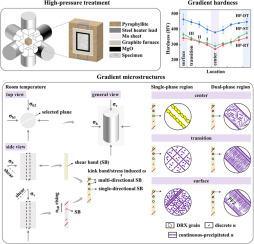High-pressure induced microstructural evolution and phase transition in Ti-55511 alloy
IF 14.3
1区 材料科学
Q1 MATERIALS SCIENCE, MULTIDISCIPLINARY
引用次数: 0
Abstract
This study demonstrates how high-pressure thermal treatment achieves a breakthrough in the trade-off relation between strength and ductility in Ti-55511 alloy, providing critical insights for aerospace materials design. When Ti-55511 alloy was processed at 5 GPa across temperatures (room temperature, 700°C, 900°C), temperature-dependent gradient microstructures were formed and governed by stress heterogeneity. This heterogeneity arises from friction constraints induced by high-pressure stress at the contacting surfaces. The surface region exhibited stress concentration with higher hardness values, while the center region displayed a lower stress state with lower hardness values. A gradient distribution of the shear bands was induced at room temperature, with shear band-assisted phase transformation occurring in the surface region. Comparing the α-phase distributions emerging in the specimens treated in single-phase and dual-phase regions, the stress promoted α precipitation for the former one and suppressed α precipitation for the latter one in the surface region. Notably, a unique α-phase fragmentation mechanism was identified in high-temperature-high-pressure treatment, with the nucleation of the β phase within the α phase, induced by α-to-β phase transformation. When the interior β phase grew up to connect the α/β interfaces on both sides of the α precipitates, the fragmentation process was completed. Besides, dynamic recrystallization occurred in the center of the specimen treated by high-pressure treatment in the single-phase region with limited α precipitation. This leads to a notable enhancement in the mechanical properties, with plasticity increased by over 11% and strength increased by ∼160 MPa compared with the original solid-solution state. These findings demonstrate the uniqueness of the high-pressure thermal treatment process and its potential as a preparation technique for titanium alloys with high-strength and high-ductility.

高压诱导Ti-55511合金组织演化与相变
该研究展示了高压热处理如何在Ti-55511合金的强度和延展性之间的权衡关系上取得突破,为航空航天材料设计提供了重要见解。当Ti-55511合金在5 GPa的温度下(室温、700°C、900°C)加工时,形成了与温度相关的梯度组织,并受应力不均匀性支配。这种非均质性是由接触面的高压应力引起的摩擦约束引起的。硬度值越高,表面区域应力越集中;硬度值越低,中心区域应力越集中。室温下,剪切带呈梯度分布,剪切带辅助相变发生在表面区域。对比单相和双相区α相的分布,应力促进了单相和双相区α相的析出,抑制了双相区α相的析出。值得注意的是,在高温高压处理中发现了一种独特的α相断裂机制,即α -β相变诱导β相在α相内成核。当内部的β相长大并连接α析出相两侧的α/β界面时,破碎过程完成。高压处理后的试样在α析出有限的单相区中心发生了动态再结晶。这导致了力学性能的显著提高,与原始固溶状态相比,塑性提高了11%以上,强度提高了~ 160 MPa。这些发现证明了高压热处理工艺的独特性及其作为高强度、高塑性钛合金制备技术的潜力。
本文章由计算机程序翻译,如有差异,请以英文原文为准。
求助全文
约1分钟内获得全文
求助全文
来源期刊

Journal of Materials Science & Technology
工程技术-材料科学:综合
CiteScore
20.00
自引率
11.00%
发文量
995
审稿时长
13 days
期刊介绍:
Journal of Materials Science & Technology strives to promote global collaboration in the field of materials science and technology. It primarily publishes original research papers, invited review articles, letters, research notes, and summaries of scientific achievements. The journal covers a wide range of materials science and technology topics, including metallic materials, inorganic nonmetallic materials, and composite materials.
 求助内容:
求助内容: 应助结果提醒方式:
应助结果提醒方式:


